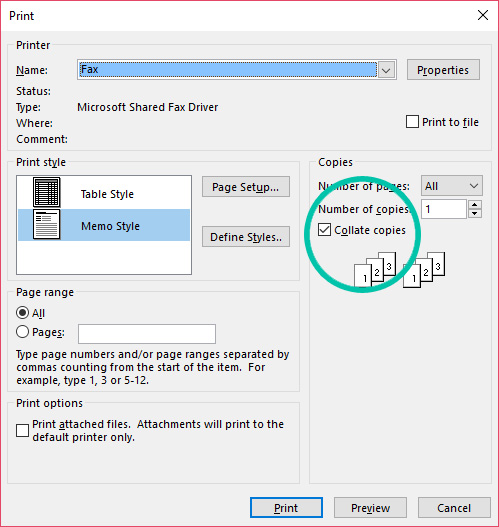

They are also a good choice when you would like your booklet to have a thicker stock of paper and if you want to incorporate index tabs.The word “collate” simply means to collect and arrange in a particular sequence or order. They can stay open by themselves which makes them perfect for training sessions and seminars. Why Choose Twin Wire: Twin wire binding allows your readers to quickly find information without having to flip through countless pages. It can handle a wide variety of book sizes - thinner books will use a smaller wire size and thicker ones will need a larger wire size It provides you with sturdy binding that can take more than just average use
#PRINTER COLLATE MEANING PROFESSIONAL#
It gives your booklet a very polished, professional appearance It lets you turn your pages 360 degrees without bending or creasing them It allows each page in your booklet to lie flat as you open them Twin-wire binding has many advantages including: You can often choose from a variety of different coloured wires and hole sizes to compliment the style of your booklet. The loops hold your book covers and pages together. Twin-wire is a method of binding booklets using a continuous hinge that is made of double wire loops that are threaded through the square, rectangular, or circular holes along the edge of your pages. Perfect bounds work really well for the following collate printing projects: Perfect bound can give you the high-quality look without the high price tag of a hardcover publication. Why Choose Perfect Bound: If you are looking for a highly professional look and feel to your books/booklets and you want a cost-effective option, then perfect bound is a great choice.

It is a great, affordable choice for short runs and on-demand printing You get clean cuts for the perfect edges on all three sides You can choose to have your cover clear-coated to make it even more durable You can have the title of your book or booklet printed along the spine You can easily stack and store them on a shelf Perfect binding books have a number of great advantages over other binding methods including: It is a popular choice for softcover books and thicker magazines and booklets. This booklet printing and binding process gives you a crisp, clean, and extremely professional-looking finished product. Once all of the pages are bound together, more adhesive is applied to the spine and then the cover is wrapped around them. Perfect bound refers to the process of grouping pages of booklets or books together and binding them with a thermal adhesive. For example, you might be preparing handouts for a class that you are teaching and you want to hand each page out separately at different times to your students. Non-collate printing is useful for times when you do not want your projects in numerical order. If you choose to not have your document collated, then the printer would print out 4 copies of page one, followed by 4 copies of page two and so on until you have all 7 pages copied. The binding can be as simple as a single staple but for longer and more professional results, you can choose from a variety of binding methods. Usually, collated print jobs are also bound to keep the pages together. This type of printing is helpful when you want to have your projects printed out as a complete set.

It would then repeat this process three more times until you have 4 complete sets of pages that are in numerical order. The printer would print one copy of page 1 then one copy of page 2 and so on until all seven of your first set are done. If you choose to have it collated, then the following would happen. You have a 7-page document, and you want 4 copies made of that document. Here is an example to help illustrate the difference between collate printing and non-collate printing. Difference Between Collate and Non-Collate Printing


 0 kommentar(er)
0 kommentar(er)
